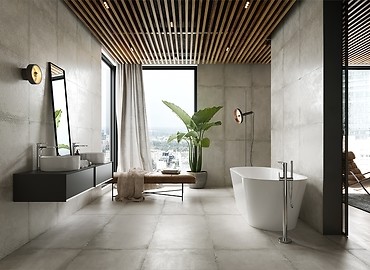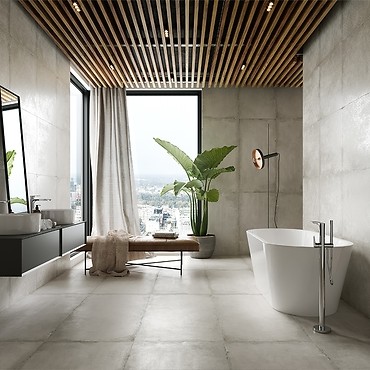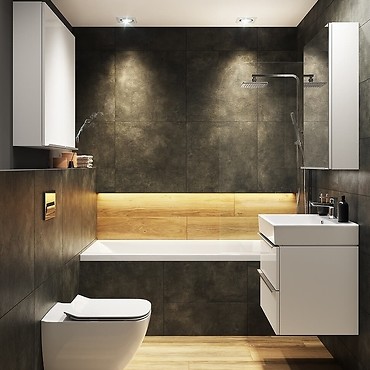Wood in the interior - nature faithfully recreated

Wood matches various trends and styles perfectly. It can be both vintage and minimalist. The Scandinavian and rustic styles would look incomplete without a wooden floor. This universality also applies to wood-look ceramic tiles.
Wood carries in it the story of the tree from which it came. Every piece is unique, and we are becoming more and more adept at mimicking this uniqueness.
Better than wood
Natural wood has its limits. Moisture, sunlight and changing temperatures eventually damage and destroy wood. Wooden planks are not a good idea with underfloor heating, as well as requiring special care and treatment. Gres tiles are free from these drawbacks in addition to being durable and resistant to scratches. Ceramic tiles allow you to add wood-like patterns and textures to your bathroom. The tiles can take up the entire floor, extending all the way to your shower space, with only glass panes separating the two zones. Such a solution makes the room appear larger and lends it a designer feel.
Eco-trends
Wood-inspired tiles are a reflection of the current trends from the world of traditional wooden flooring, but they also set their own trends. Examples include bleached, light-coloured tiles which are perfect for the ultra-popular Scandinavian interiors. Elements sporting wood-grain patterns breathe life into the so-called herringbone pattern, which does not have to be vintage at all – large-size tiles turn a classic into a new, bold pattern. The possibilities are plentiful.
The transition from wood to ceramics has its perks – it allows you to connect spaces with differing functions. The same herringbone floor or large ship deck planks can be laid in the kitchen, the living room and on the terrace. Forget about boundaries and thresholds – let the tiles effortlessly connect all rooms. They can endure both a dropped cup, a friend wearing high heels, as well as rain and frost outside. You change as years go by, but the tiles remain eternally young.
Spatial thinking
Wood-inspired tiles do not have to stay on the floor. They can be used to frame the bath tub, cover one of the walls entirely or just the areas around the washbasin or toilet. If you are bold enough, you can experiment with the tonal look and choose wood for both the floor and the walls.
Colour and style
Calm backgrounds make the beauty of wood stand out, especially white (and light-coloured in general) tiles. Make sure that the decorative elements are not in competition with the texture of the wood and its grain – this does not mean that you should not add any, however. Shiny and metallic elements with fine geometric or stylised floral patterns are great for this purpose. Cersanit’s Naris collecion offers white and patchwork-patterned structured tiles which appear as though made up of several smaller ones. Such a discreet decoration perfectly matches flooring which imitates planks of wood, like the I Love wood series by Cersanit, which perfectly mimics their beauty.
See more tips in this category
-
TECH LINE - CONCEALED WC FRAMES AND FLUSH BUTTONS
TECH LINE OPTI concealed WC frames and the ultra-narrow TECH LINE BASE will allow us to save the available ... -
VIRGO - Sign of Beauty
The VIRGO concept collection is a unique proposal for all those looking for stylish, designer solutions ...








